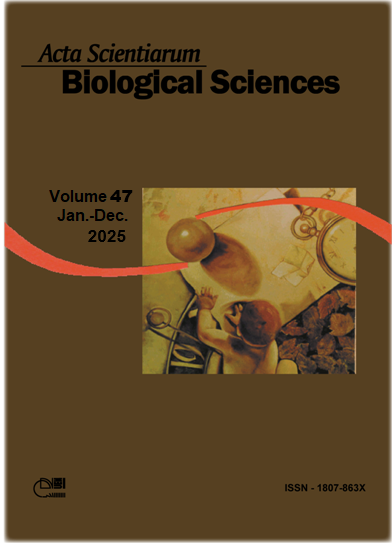Assessment of biology students' knowledge about the fauna and flora of the Campos Gerais
Resumo
Brazil stands out globally for its rich biodiversity, presenting a vast field of study. Despite this natural wealth, the population exhibits limited knowledge about it. This study was conducted at the Universidade Estadual de Ponta Grossa with Biology students to assess their perception of the native fauna and flora of Campos Gerais, Paraná. Data were collected in 2023 through questionnaires with 36 participants, including students at the beginning and end of their course. The results showed that, although students at the end of the course had slightly higher recognition of species, the difference was not statistically significant. Interestingly, the identification of exotic species surpassed that of many native species, including endangered species such as the giant anteater. We conclude that a knowledge gap exists regarding native species among future biologists and educators, underscoring the need to integrate place-based teaching approaches and revise educational materials.
Downloads
Referências
Almeida, F. S., & Vargas, A. B. B. (2017). Bases para a gestão da biodiversidade e o papel do gestor ambiental. Diversidade e Gestão, 1(1), 10-32.
Alves, G. H. Z., Santos, R. S., Figueiredo, B. R. S., Manetta, G. I., Message, H. J., Pazianoto, L. H. R., Guimarães, G. B., Benedito, E., & Couto, E. V. (2019). Misguided policy may jeopardize a diverse South Brazilian environmental protection area. Biota Neotropica, 19(1), e20180574. https://doi.org/10.1590/1676-0611-BN-2018-0574
Andrade, B. O., Bonilha, C. L., Overbeck, G. E., Vélez-Martin, E., Rolim, R. G., Bordignon, S. A. L., Schneider, A. A., Vogel Ely, C., Lucas, D. B., Garcia, É. N., dos Santos, E. D., Torchelsen, F. P., Vieira, M. S., Silva Filho, P. J. S., Ferreira, P. M. A., Trevisan, R., Hollas, R., Campestrini, S., ... Boldrini, I. (2018). Classification of South Brazilian grasslands: Implications for conservation. Applied Vegetation Science, 22(1), 168-184. https://doi.org/10.1111/avsc.12413
Bianconi, G. V., Silva, M. D., & Roque, A. F. (2020). Entre Campos: Ciência e Educação nos Campos Gerais do Paraná. INPCON: Instituto Neotropical.
Delazeri, F., & Muller, E. S. (2017). Compreensão de estudantes do Ensino Fundamental sobre animais nativos e exóticos. Acta Ambiental Catarinense, 14(1/2). https://doi.org/10.24021/raac.v14i1/2.4154
Frehse, F. D. A., Braga, R. R., Nocera, G. A., & Vitule, J. R. S. (2016). Non-native species and invasion biology in a megadiverse country: scientometric analysis and ecological interactions in Brazil. Biological Invasions, 18, 3713-3725. https://doi.org/10.1007/s10530-016-1260-9
Garcia, L. M., Iarmul, J., Rosa, C. D., Tardivo, R. C., & Nuvoloni, F. M. (2021). Population ecology and conservation status of Parodia carambeiensis (Cactaceae). Rodriguésia, 72, e00842020. https://doi.org/10.1590/2175-7860202172125
Guimarães, G. B., Melo, M. S. D., Piekarz, G. F., Moreira, J. C., Liccardo, A., & Mochiutti, N. F. (2012). Geoparque dos Campos Gerais (PR): proposta. CPRM.
Marques, D. K. S., & Resende, E. K. (2005). Distribuição do tucunaré Cichla cf. monoculus (Osteichthyes, Cichlidae) no Pantanal. Embrapa.
Melo, E. P. D., Simiao-Ferreira, J., Melo, H. P. D., Godoy, B. S., Daud, R. D., Bastos, R. P., & Silva, D. P. (2021). Exotic species are perceived more than native ones in a megadiverse country as Brazil. Anais da Academia Brasileira de Ciências, 93, e20191462. https://doi.org/10.1590/0001-3765202120191462
Melo, M. S., Moro, R. S., & Guimarães, G. B. (2010). Patrimônio natural dos Campos Gerais. Editora UEPG. https://www.academia.edu/4379818/Patrimonio_Natural_dos_Campos_Gerais
Myers, N., Mittermeier, R. A., Mittermeier, C. G., Fonseca, G. A., & Kent, J. (2000). Biodiversity hotspots for conservation priorities. Nature, 403(6772), 853-858. https://doi.org/10.1038/35002501
Ota, R. R., Frota, A., Oliveira, A. G., Nardi, G., Proença, H. C., Message, H. J., Penido, I. S., Ganassin, M. J. M., & Agostinho, A. A. (2019). Brazilian fish fauna threatened by a proposal for a new law protecting invaders. Biodiversity and Conservation, 28, 787-789. https://doi.org/10.1007/s10531-018-1683-y
Proença, M. S., Dal-Farra, R. A., & Oslaj, E. U. (2017). Espécies nativas e exóticas no ensino de ciências: Uma avaliação do conhecimento dos estudantes do ensino fundamental. Contexto & Educação, 32(103), 213-247. https://doi.org/10.21527/2179-1309.2017.103.213-247
R Core Team. (2023). R: A language and environment for statistical computing. R Foundation for Statistical Computing. https://www.R-project.org/
Santos, F. S. (2010). A importância da biodiversidade. Revista Científica de Educação a Distância, UNIMES-VIRTUAL, Ed. Especial, 6109.
Silva-Diogo, O., Goebel, L. G. A., Sousa, M. R., Gusmão, A. C., Costa, T. M., Souza Jesus, A., & Cavalcante, T. (2020). Expansão da área de ocorrência do lobo-guará, Chrysocyon brachyurus (Carnivora, Canidae) no bioma Amazônico. Oecologia Australis, 24(4), 928-937. https://doi.org/10.4257/oeco.2020.2404.15
Soga, M., Evans, M. J., Yamanoi, T., Fukano, Y., Tsuchiya, K., Koyanagi, T. F., & Kanai, T. (2020). How can we mitigate against increasing biophobia among children during the extinction of experience? Biological Conservation, 242, 108420. https://doi.org/10.1016/j.biocon.2020.108420
SOS Mata Atlântica. (2023). Mata Atlântica. https://www.sosma.org.br/causas/mata-atlantica/
The IUCN Red List of Threatened Species. (2022). Red list of threatened species. https://www.iucnredlist.org/
Wrege, M. S., Fritzsons, E., Soares, M. T. S., Bognola, I. A., Sousa, V. A., Sousa, L. P., ... Ferrer, R. S. (2017). Distribuição natural e habitat da araucária frente às mudanças climáticas globais. Pesquisa Florestal Brasileira (PFB), 37(91), 331-346. https://doi.org/10.4336/2017.pfb.37.91.1413
Copyright (c) 2025 Ana Lucia de Souza Macedo, Gustavo Henrique Zaia Alves (Autor)

This work is licensed under a Creative Commons Attribution 4.0 International License.
DECLARAÇÃO DE ORIGINALIDADE E DIREITOS AUTORAIS
Declaro que o presente artigo é original, não tendo sido submetido à publicação em qualquer outro periódico nacional ou internacional, quer seja em parte ou em sua totalidade.
Os direitos autorais pertencem exclusivamente aos autores. Os direitos de licenciamento utilizados pelo periódico é a licença Creative Commons Attribution 4.0 (CC BY 4.0): são permitidos o compartilhamento (cópia e distribuição do material em qualqer meio ou formato) e adaptação (remix, transformação e criação de material a partir do conteúdo assim licenciado para quaisquer fins, inclusive comerciais.
Recomenda-se a leitura desse link para maiores informações sobre o tema: fornecimento de créditos e referências de forma correta, entre outros detalhes cruciais para uso adequado do material licenciado.












1.png)




3.png)













